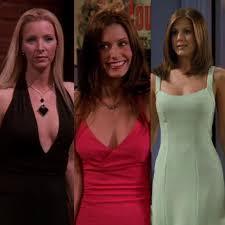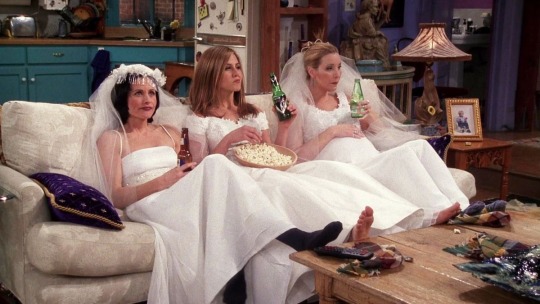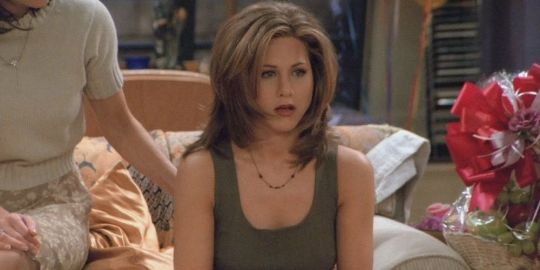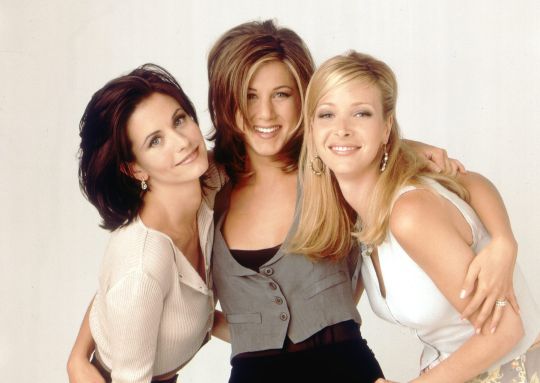Don't wanna be here? Send us removal request.
Text
Introduction
Friends (1994) is a popular American sitcom with ten seasons which ran until 2004. This beloved sitcom is popular for many reasons, one of the most significant being how relatable the characters are. However, when taking a deeper look into the series it becomes clear that there are significant stereotypical gender norms placed on each character throughout the show. Kopecká writes “But it wasn’t until much later that I recognized how problematic this TV show can be. I was twenty when I first noticed how it promotes gender stereotypes, mocks people for being gay or transgender and not being masculine or feminine enough. Suddenly, I started to feel disappointed”(Kopecká). As mentioned in the quote, this show promotes negative stereotypes surrounding gay and transgender communities with characters like Carol and Susan, which is extremely harmful to such communities. However, the focus of this discussion will be on the portrayal of gender which was extremely problematic looking back on the show now. Women have been historically marginalized and misrepresented in the media and this show is a great example of that. “Gendered Media: The Influence of Media on Views of Gender” written by Julia T. Wood makes an excellent point writing, “Women are portrayed as significantly younger and thinner than women in the population as a whole, and most are depicted as passive, dependent on men, and enmeshed in relationships or housework”(Wood 33). This specifically applies to the main female characters, Monica, Rachel, and Phoebe. They are all young and thin, any of these characteristics can apply to the characters. Each woman is always dressed in very feminine clothing, this is just one example of how narrow the expectations are for femininity. Monica is specifically portrayed to be enmeshed in family life, Rachel as dependent on men, and Phoebe as passive and enmeshed in relationships.


Phoebe, Monica, and Rachel in Dresses . https://encrypted-tbn0.gstatic.com/images?q=tbn:ANd9GcSO94zR3hNfSfgqeP_colIWyJK_Wh9z1AewQw&s. Accessed 18 Apr. 2025.
Friends All The Wedding Dresses . https://cdn.vox-cdn.com/thumbor/r-5gMELE5ABca4J-GmcAzNhx85k=/0x0:1920x1080/1200x0/filters:focal(0x0:1920x1080):no_upscale()/cdn.vox-cdn.com/uploads/chorus_asset/file/8634711/friends_all_the_wedding_dresses.jpg. Accessed 18 Apr. 2025.
However it is important to note that the male characters also perpetuate harmful gender norms. For example in the episode titled “The One with the Metaphorical Tunnel” Ben is dropped off to Ross by Susan and Carol with a barbie in hand. Ross, who is Ben’s father, does not approve of his son playing with a barbie and tries to encourage him to play with a GI Joe doll instead. Carol and Susan try to tell Ross that it’s not a big deal but he is still very bothered by it. Susan even makes a point of saying “So he’s got a doll so what? Unless you're afraid he's gonna grow up to be in show business”(Friends S:3, E:4). Alluding to the fact that Ben has two mothers and Ross may think they encouraged Ben to pick out the doll, typically thought to be a girl toy. This moment goes to show how harmful the perpetration of gender norms can be, and how being gay or even a boy playing with “girl toys” is portrayed as a negative thing. Instances like this are common in the show and it emphasizes the rigidity of gender norms in our society. The women in friends are portrayed in significantly negative ways and perpetuate the negative gender stereotypes placed on women.
youtube
1 note
·
View note
Text
Monica
In the show each character has their own stereotype that they conform to, and the women are portrayed in significantly negative ways. Monica is portrayed as the mother of the group, she is neurotic, hyper, and obsessive. She also carries great insecurity due to her teen years when she was overweight. The show constantly comments on this, and it is made clear that she was viewed as unattractive during this time. In the episode titled “The One with All the Thanksgivings” there is a flashback scene where we see Monica and Rachel who are still in highschool, and Ross introducing them to Chandler. When he is introduced to Monica he immediately scoffs and later says “..I just don't want to be stuck here all night with your fat sister”(Friends S:5, E:8). Monica is in the background when he says this and hears him, this is a significant moment because it perpetuates the idea that women who are not thin are unattractive. This is the only time a significant character is shown to be a bigger size and she is immediately labeled as undesirable. According to a study titled “Gender and Media Representations” from the National Library of Medicine “Girls were often portrayed as focusing more on their appearance, as well as being judged for their appearance…”(Santoniccolo et al.). In addition Chandler and Monica go on to get married later in the show when she is no longer overweight, alluding to the idea that being thin is the only way for a woman to be considered attractive. This is a very harmful stereotype to be shown on television and it further allows for gender expectations like “women should be thin” to be accepted in society.
Timestamp: 4:23
Monica is obsessed with the idea of having a family which is another significant and harmful gender norm that is placed on women. According to a study titled “Gender Representation on Gender Targeted Television Channels” from the National Library of Medicine, “The suggestion that family life and parenthood are of greater significance to women than to men is also implicit in the fact that parental status is more often made explicit for women than for men”(Daalmans et al.). Monica’s obsession with having a family may initially come across as a funny or relatable feeling for some. However she often blames herself for not being able to achieve this and the implications of this aspect of her character are a harmful and offensive portrayal of women. This concept is such a large part of her character that it takes away from who she is as a person. There is no obsession with having a family for any of the male characters in the show. In fact Ross who actually has a son is barely seen with him throughout the show. This further perpetuates the idea that having and taking care of a family is a “womens job”. This is supported by Wood reporting “Equally interesting is how males are not presented. J. D. Brown and K. Campbell (1986) report that men are seldom shown doing housework”(Wood 32).

Monica Wants a Baby . Reddit , https://www.reddit.com/media?url=https%3A%2F%2Fi.redd.it%2F1c6mc5ghkom51.jpg. Accessed 18 Apr. 2025.
1 note
·
View note
Text
Rachel
Rachel is initially portrayed as spoiled, snobby, helpless, and reliant on her male friends, which does change in later seasons. However throughout the entire show she is portrayed as emotional, and obsessed with shoes and clothes. Mary writes “Rachel green is the most stereotypical female character in this classic TV series. The show itself revolves around how Rachel embodies negative female characteristics and although they are normalized, her actions are used for comedic effect”(Mary). Rachel is portrayed as what is thought of as a “typical woman” and the comedy that surrounds her actions is quite demeaning to women. There is laughter when she is bad at her job at the coffee house, but it is also passed off as expected. This is harmful because it perpetuates the idea that women are not good workers, or are inherently lazy and unintelligent.

Rachel The One Where Rachel Finds Out . https://static1.srcdn.com/wordpress/wp-content/uploads/2020/02/Rachel-The-One-Where-Rachel-Finds-Out-Season-1-Friends.jpg. Accessed 18 Apr. 2025.
In later seasons her character sees some significant development, she becomes successful in her job and independent, even balancing motherhood and work life. This does challenge traditional gender norms placed on women at a first glance. However when taking a deeper look it becomes clear that “Although the series does a reasonably good job at displaying female independence in the working world, the jobs we see Rachel having are those only associated with the typical female stereotype”(Mary). This is referring to the fact that she became successful in the fashion world, a job typically thought to be “for women”. The job she has is associated with femininity, this only further perpetuates the stereotypes that surround women. Her stereotypical feminine representation, being skinny and pretty, also impacted the fact that she was able to work in this field and become so successful. Mary makes an important point when she goes on to mention that “...when she finally gets her dream job, she is expected to leave everything behind when Ross confesses his love for her in the final episode of the series”(Mary). The fact that she was expected to leave everything behind that she worked so hard to achieve for a man is a very harmful and common expectation among women. Historically women have been expected to stay home and take care of the family while men go to work. Ross asking Rachel to leave behind everything that she has worked so hard for is inherently selfish, and enforces the idea that women should not be chasing their dream job and should instead be homemaking.
Timestamp: 2:46
youtube
1 note
·
View note
Text
Phoebe
Phoebe is portrayed as ditzy, passive, and naive throughout the show. She also conforms to the typical thin, beautiful, and blonde expectation of women. She is very independent and this can be viewed as a defiance of typical gender norms. However Kopecká makes an important point writing “Whilst there are some exceptions to the unfortunate rule where women are independent and men are able to express their feelings, stereotypes and tropes prevail”(Kopecká). Therefore, although there may be moments where characters in the show appear to step away from traditional gender expectations their character as a whole is based in these gender norms, and are impossible to escape. For example there is a focus on Phoebe's relationships with men throughout the show and a lot of her character plot is based on the man that she is seeing. In this clip, Phoebe is meeting her boyfriend’s parents and comes across very badly, she is ditzy and has very poor social awareness, perpetuating the idea that women are unintelligent.
Timestamp: 3:18
youtube
Another example of Phoebe being portrayed as naive can be seen in the episode titled “The One Where Eddie Moves In”. She makes a music video to her song and shows it to the friend group. In this video it is clear that instead of her singing there is a voice over from someone else. Phoebe goes on to believe that it is her voice and says “I've never heard myself sing before, I mean except in my own head. Oh! This is so cool! Now I can hear what you hear!”(Friends S:2, E:17). Everyone in the group looks around at each other in disbelief and makes it very obvious that she is not the one singing, but she does not understand. This portrayal of Phoebe is extremely harmful to women and adheres to negative gender norms such as women being ditzy or naive.
Timestamp: 1:00
youtube
As mentioned before Phoebe also adheres to the typical expectation for women to be thin, beautiful, and blonde. She dresses in very feminine ways although her style is different compared to Rachel and Moinica, who dress more similarly. She is usually wearing skirts or dresses and is adorned with jewelry. This is harmful because it adheres to the very narrow expectation of acceptable expressions of femininity. Phoebe never strays from this type of dress and it is very clear that this is what was presumed to be acceptable for women. Portraying women like this on television only further perpetuates the idea that this is how women are supposed to look.

Phoebe Buffay Friends Style . College Fashion , https://www.collegefashion.net/wp-content/uploads/2019/01/phoebe-buffay-friends-style.jpg. Accessed 18 Apr. 2025.
1 note
·
View note
Text
Conclusion
Overall, it is clear that the women in friends are portrayed in significantly negative ways and perpetuate the negative gender stereotypes placed on women. Although there seem to be moments where the characters break away from gender norms, the essence of who they are is rooted in these expectations.

Monica, Rachel, Phoebe. Half The Sky , https://www.halftheskyasia.com/rails/active_storage/blobs/redirect/eyJfcmFpbHMiOnsibWVzc2FnZSI6IkJBaHBBeEVpR3c9PSIsImV4cCI6bnVsbCwicHVyIjoiYmxvYl9pZCJ9fQ==--cf742ffc932338f980f8e6038c423cb4d6eca857/c9f1facce22eabfd6854d08cfab9aaaa.jpg. Accessed 18 Apr. 2025.
1 note
·
View note
Text
Works Cited
Daalmans, Serena, Kleemans, Mariska, Sadza, Anne. “Gender Representation on Gender-Targeted Television Channels: A Comparison of Female- and Male-Targeted TV Channels in the Netherlands.” Sex roles vol. 77,5 (2017): 366-378. doi:10.1007/s11199-016-0727-6
Kopecká, Mahulena. “Could It Be Any More Sexist? Friends as a Problematic TV Show.” Medium, 26 May 2020, medium.com/@mahulena_k/could-it-be-any-more-sexist-friends-as-a-problematic-tv-show-3dafd82e83e.
Mary, Clare. “Stereotypical “Friends.”” Medium, 14 Feb. 2020, medium.com/@clarehofheinz/stereotypical-friends-786a5b88c542.
Santoniccolo, Fabrizio,Trombetta, Tommaso, Paradiso, Noemi, Maria, Rollè, Luca. “Gender and Media Representations: A Review of the Literature on Gender Stereotypes, Objectification and Sexualization.” International journal of environmental research and public health vol. 20,10 5770. 9 May. 2023, doi:10.3390/ijerph20105770
Wood, Julia T. Gendered Media: The Influence of Media on Views of Gender . 1994.
Popular Source Links
0 notes